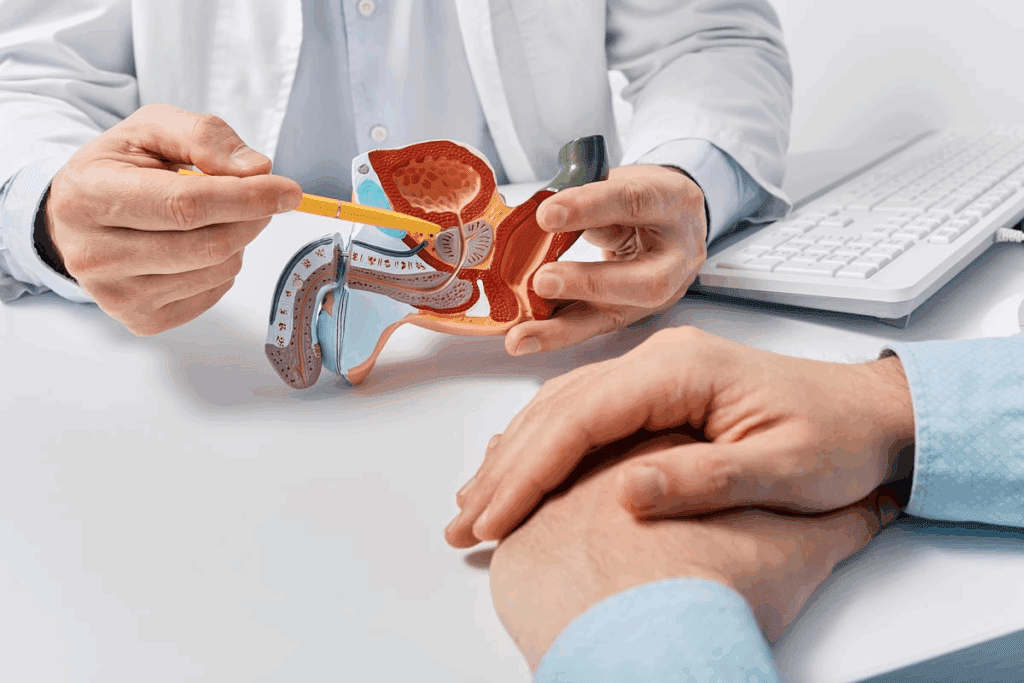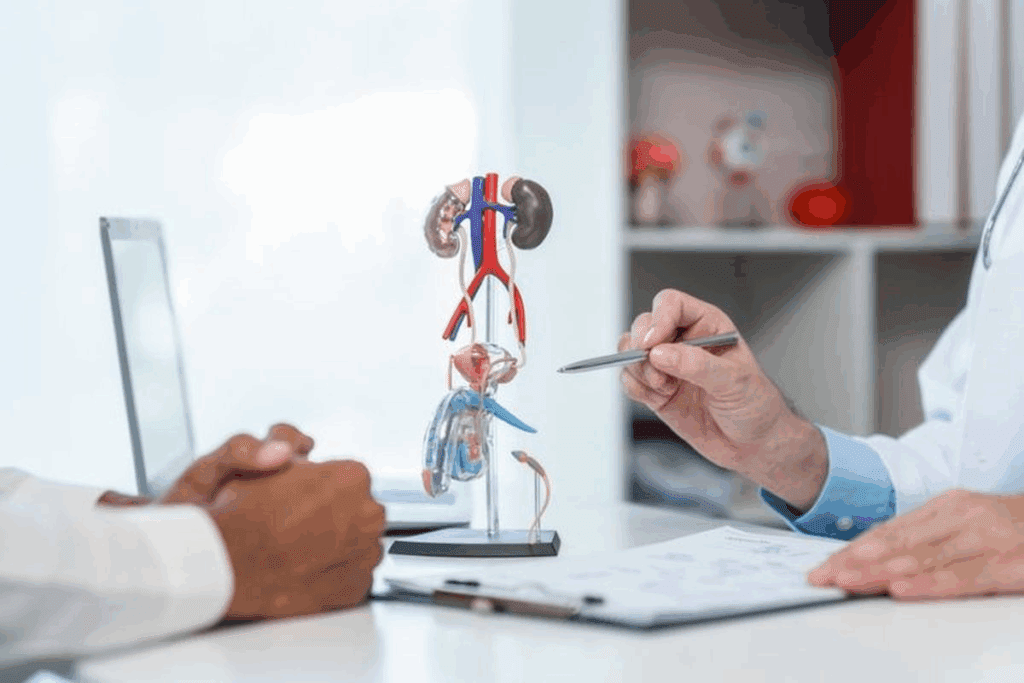Last Updated on November 25, 2025 by Ugurkan Demir

For over eight decades, Androgen Deprivation Therapy (ADT) has been key in fighting prostate cancer, mainly for advanced cases.Discover what adt prostate cancer cancer treatment is and its benefits.
Getting a prostate cancer diagnosis can feel overwhelming. It’s important to understand your treatment options. ADT lowers androgen hormones to stop cancer cells from growing.
At Liv Hospital, we focus on you. We give you all the details about ADT and other hormone therapies. Our team uses top medical protocols to help you.

Androgen Deprivation Therapy (ADT) is a key treatment for prostate cancer. It has changed a lot over time. We’ll look into what ADT is, why it’s used, and how it has developed.
ADT, or Androgen Deprivation Therapy, lowers male hormones in the body. Its main goal is to slow prostate cancer growth, which androgens like testosterone can fuel. By reducing these hormones, ADT helps control cancer, improving patient results.
ADT often uses LHRH agonists to lower androgen levels. LHRH agonists first raise testosterone levels but then lower them by affecting the pituitary gland.
The idea of ADT started in the 1940s, when it was found that prostate cancer responds to hormones. Over the years, ADT has grown, thanks to new medical tech and understanding of cancer. The 1980s saw a big leap with LHRH agonists, making treatment better and easier.
Now, ADT is a vital part of prostate cancer treatment. Research keeps going to make it better and reduce side effects. As we learn more about prostate cancer, ADT’s role will likely grow, giving hope to patients everywhere.

Hormone therapy, also known as androgen deprivation therapy (ADT), is key in treating prostate cancer. It slows or stops cancer cell growth by lowering male hormones like testosterone and dihydrotestosterone (DHT) in the body.
To understand ADT, knowing the role of androgens in prostate cancer is vital. Androgens, like testosterone and DHT, fuel prostate cancer cell growth.
Androgens make prostate cells grow, including cancerous ones. By lowering androgen levels, ADT slows or stops cancer growth. It’s great for advanced cancer or those at high risk of it coming back.
ADT reduces androgen levels in the body, starving prostate cancer cells of growth hormones. There are several ways to do this:
Understanding ADT and its role in prostate cancer helps patients choose their treatments wisely. ADT is a vital part of prostate cancer care, helping control cancer and improve life quality.
ADT for prostate cancer offers several treatment options. Androgen Deprivation Therapy (ADT) is key in managing advanced prostate cancer. It aims to lower male hormones that help cancer cells grow.
LHRH agonists are a type of ADT medication. They first increase testosterone levels but then lower them. Drugs like leuprolide, goserelin, histrelin, and triptorelin are used because they work well.
Here’s a comparison of some commonly used LHRH agonists:
| Drug Name | Administration Frequency | Notable Brand Names |
| Leuprolide | 1-6 months | Lupron, Eligard |
| Goserelin | 1-3 months | Zoladex |
| Histrelin | 1 year | Vantas |
| Triptorelin | 1-6 months | Trelstar |
Other ADT options include LHRH antagonists and anti-androgens. LHRH antagonists, like degarelix, quickly lower testosterone levels. Anti-androgens, such as bicalutamide and enzalutamide, block androgens from acting on cancer cells.
We mix these therapies to fit each patient’s needs. The right treatment depends on the cancer stage, patient health, and personal choices.
ADT hormone shots for prostate cancer have evolved, giving patients more choices. These shots can be given under the skin or into a muscle. They contain GnRH and LHRH agonists or antagonists. These substances help lower androgen levels in the body.
One common way to get ADT is through injections every 6 months. This is great for those who don’t want to visit their doctor too often. Formulations given every 6 months release the active ingredients slowly. This keeps androgen levels low consistently.
While injections every 6 months are popular, other schedules are available too. Some patients might get shots more often, like every 1, 3, or 4 months. This depends on their treatment plan and the medication used.
Other administration options include:
We help patients choose the best shot schedule based on their needs and medical history. By providing different ADT options, we can make treatment plans that work better for each patient. This helps improve their outcomes and quality of life.
Androgen Deprivation Therapy (ADT) is key in managing prostate cancer, mainly in advanced stages. We use ADT in different situations to help patients.
Key Applications of ADT:
In metastatic prostate cancer, ADT lowers androgen levels to slow disease growth. It’s vital for easing symptoms in advanced disease.
ADT in metastatic prostate cancer is proven to control disease and manage symptoms well.
For high-risk localized prostate cancer, ADT is paired with radiation therapy. This combo boosts treatment success and improves patient results.
Research shows adding ADT to radiation therapy boosts survival and lowers recurrence risk.
Benefits of ADT with Radiation Therapy:
Combining ADT with radiation therapy offers a more thorough treatment for high-risk localized prostate cancer.
Recent breakthroughs in prostate cancer hormone treatment drugs have changed the game in oncology. We’re seeing a big change in how we treat prostate cancer. Now, there’s a focus on using combination therapies that attack the disease from different angles.
The ARCHES trial in 2025 brought us exciting news. It showed that mixing enzalutamide with Androgen Deprivation Therapy (ADT) is a game-changer for prostate cancer treatment. This big study found that adding enzalutamide to ADT greatly improved survival rates for patients.
This trial’s findings highlight the power of dual therapy. By hitting prostate cancer from two sides, we can slow down its growth and make life better for patients.
But the ARCHES trial isn’t the only one making waves. Other new combo therapies are also showing great promise. Researchers are working on new antiandrogens that block testosterone or stop androgen receptors from moving into the nucleus.
These new treatments aim to boost the effectiveness of current hormone therapies. By mixing different treatments, we might be able to beat resistance and get better results for patients.
The future of treating prostate cancer is all about personalized medicine. We’re moving towards treatments that fit each patient’s unique cancer. As research keeps moving forward, we’ll see even more targeted and effective treatments come to light.
ADT treatment for prostate cancer has shown remarkable benefits. It improves patient outcomes by reducing androgen levels. This helps control cancer cell growth and spread, boosting survival rates and quality of life.
Many studies show ADT improves survival rates in prostate cancer patients. It deprives cancer cells of hormones needed for growth. This can shrink tumors and slow disease progression.
A leading oncologist notes, “ADT has been a game-changer in managing advanced prostate cancer. It offers patients a better chance at survival.”
The benefits of ADT in disease control are many:
While ADT manages prostate cancer well, its impact on quality of life is key. Common side effects include hot flashes, fatigue, and body composition changes. Yet, many patients see improved quality of life due to reduced cancer symptoms.
“The efficacy of ADT in improving survival outcomes is undeniable, but it’s equally important to address the quality of life issues that arise during treatment.” –
A renowned oncologist
To lessen side effects and boost quality of life, healthcare providers suggest lifestyle changes and supportive care. These may include:
By balancing ADT’s benefits and side effects, healthcare providers can offer personalized care. This improves both survival and quality of life for prostate cancer patients.
ADT is a key part of treating prostate cancer, but it comes with side effects. These side effects can affect how well a patient lives with the disease. They happen because ADT lowers androgen levels in the body.
Side effects of ADT include hot flashes, fatigue, muscle weakness, decreased libido, and decreased bone density. These happen because ADT lowers androgen levels. Androgens are important for many body functions.
Hot flashes are a big problem for many patients. Fatigue makes daily life hard. Muscle weakness and bone density issues can make patients weaker and increase fracture risks.
It’s important to manage ADT side effects to keep patients’ quality of life good. Making lifestyle changes can help. Regular exercise and a balanced diet can fight fatigue and keep bones strong.
Medicines like bisphosphonates can boost bone density. This lowers osteoporosis risk. For hot flashes, certain antidepressants or anti-seizure drugs can help. Counseling and support groups offer emotional support and help with the mental side of ADT.
Understanding ADT side effects and how to manage them is key. Healthcare providers can help patients deal with prostate cancer treatment better.
We’ve looked into how Androgen Deprivation Therapy (ADT) is key in treating prostate cancer. We’ve covered what it is, its history, and how it’s used. Looking ahead, ADT will keep being a big part of fighting this disease.
New studies and breakthroughs will make ADT better. It will work more effectively and have fewer side effects. We’re excited about new treatments and ways to give ADT. These changes will help shape how we treat prostate cancer.
It’s important to know about ADT in prostate cancer. Understanding it helps us improve treatment and patient care. By keeping up with ADT research, we can offer better treatments. This will make life better for those going through ADT.
Androgen Deprivation Therapy (ADT) is a treatment for prostate cancer. It lowers male hormones in the body. This can slow or stop prostate cancer cells from growing.
Hormone therapy for prostate cancer lowers androgens in the body. Androgens fuel prostate cancer cell growth. ADT reduces testosterone and other androgens.
LHRH agonists are used in ADT to lower androgen levels. They first increase luteinizing hormone production. Then, they decrease testosterone production. Examples include leuprolide and goserelin.
There are several ADT treatments for prostate cancer. LHRH agonists are common and come in different forms. They are often given every 6 months.
ADT is given through injections, every 1-6 months. The schedule depends on the patient’s needs and preferences.
ADT improves survival, disease control, and quality of life for prostate cancer patients. It’s used for metastatic disease and as adjuvant therapy with radiation.
Side effects of ADT include hot flashes, fatigue, and osteoporosis. Lifestyle changes and medications can help manage these side effects.
ADT is key in treating metastatic prostate cancer. It helps control the disease and improve survival.
ADT enhances radiation treatment’s effectiveness. It reduces androgen levels, making prostate cancer cells more susceptible to radiation.
New combination therapies, like enzalutamide plus ADT, have shown promise. They aim to improve outcomes for prostate cancer patients.
Subscribe to our e-newsletter to stay informed about the latest innovations in the world of health and exclusive offers!